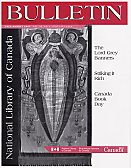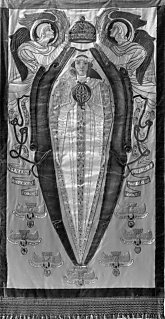 |
 
July / August
2001
Vol. 33, no. 4
|
The Lord Grey Banners: Unraveling Clews at 395 Wellington
Maria Belanger
Research and Information Services

Courtesy of James Topley / National Archives of Canada PA-197758. |
For the April 2001 Savoir Faire presentation, the National Library of Canada was fortunate to have Dr. Jennifer Salahub give an illustrated talk on Lord Grey’s banners. Dr. Salahub, a textile historian with an M.A. in Canadian art history from Concordia University and a Ph.D. in design history from the Royal College of Art in London, England (1998), considers herself a detective, "unraveling clews, tangled threads and knotty issues." Using a series of slides, Dr. Salahub enthusiastically described to her audience how she uncovered information about the banners and ultimately discovered a mystery banner in the collection of the National Archives of Canada.
While Lord Grey was the governor general of Canada, from 1904 through 1911, he wrote to some lady friends in England asking them to design and embroider a series of banners, which he wanted to present to educational institutions in Canada. The central theme of the banners was to be St. George, the patron saint of England, slaying the dragons of evil, wherever they may be. These banners were to be hung where they could be seen on a daily basis, inspiring young Canadian males to faithfully serve the Empire. Today, these banners can be found hanging in educational institutions such as McGill University, the University of Toronto, Queen’s University, and the University of Guelph, as well as in Rideau Hall.
The banners were considered vice-regal gifts and were designed by women of royalty or the wives of prominent men. Unfortunately, even though they had been on display for many years, not much was known about their provenance. According to Dr. Salahub, this was for a variety of reasons: "A Modernist horror of Victorian aesthetics; the very didactic nature of banners; and even their location within educational institutions (libraries) as opposed to gallery or museum settings."
In 1996, while hard at work on her doctoral studies, Dr. Salahub became aware of research conducted by Robert Common on the Lord Grey banners. While Mr. Common was studying at Queen’s University, a childhood memory was triggered by a banner depicting a standing St. George and the Dragon. The banner was on display in the Douglas Library of Queen’s University. It reminded him of the Mounted St. George and the Dragon banner that he had seen hanging in the library of Macdonald College in Montreal as a child. His curiosity was piqued. Were there more banners? What was the history behind the banners? After conducting extensive research, which included consulting Lord Grey’s letters, obtaining information by writing to various educational institutions and talking to various family members (including Lady Meynell’s daughter), he came to the conclusion that there were nine banners in total. By 1982, he had tracked down seven of the nine banners, among them one at the University of King’s College in Nova Scotia, which had been signed "E.D. Pinner 1907." But what happened to the two others?
A magazine article found in the Grey file and entitled "To Adorn Our College Halls" (Canadian Life and Resources, c1910) contained photographs of some banners and also listed the names of several women who had been involved with them: Queen Alexandra, the Princess of Wales (Queen Mary), Mrs. George Frederick Watts and Lady Meynell.
Supported by Robert Common, Dr. Salahub began her own quest for information about the banners. The topic of her research was the influence of British embroidery traditions and design on middle-class taste and domestic embroidery in Canada. Dr. Salahub hunted through libraries and archives across Canada and England, enlisting the support of friends and colleagues in her quest for answers. She "was fascinated by the fact that Grey had chosen a medium closely associated with the inculcation of femininity (embroidery)." Dr. Salahub explained, "This seemed contradictory at best. However, I soon discovered that Grey’s agenda was predicated on the understanding that Canadians saw the colony as Britannia’s dutiful daughter - the use of embroidery, with its self-conscious reference to historic embroidery traditions promoted a sense of hierarchy in Canada at the beginnings of the twentieth century."
Thumbing through art and design magazines, she was lucky enough to stumble upon an article on the E.D. Pinner banner, complete with an illustration. The article identified a Mrs. Davis as the creator of the banner. After travelling to Pinner (Middlesex), Dr. Salahub found out that E.D. was Edith (Webster) Davis. She was a well-known embroiderer of banners who also worked with her husband, Louis Davis.
Dr. Salahub described four distinct styles of banners: the first group was created by the Royal Embroiderer; the second, the largest stylistic group, was associated with Lord Grey’s aunt Lady Wantage, and his cousin Lady Meynell and her household; the third group was represented only by the signed E.D. Pinner 1907 banner; and the fourth stylistic group embodied the subtle, spiritual and feminine qualities associated with Mary Watt.
In Robert Common’s file, Dr. Salahub came across a letter dated from the 1980s from Patricia Kennedy of the National Archives of Canada. The letter informed him that there was a tapestry/banner in the Archives’ collection. Robert Common did not think it was relevant to his research so he did not pursue it further. After moving to Ottawa, Dr. Salahub became curious about it and contacted Patricia Kennedy to make arrangements to view it. To her great delight, it was an embroidery, not a tapestry as they had been led to believe. It was also signed and dated "worked by Agnes Sephton 1907". The banner included the image of St. George and the Dragon, and a verse about banners was embroidered on its circumference. It also fell into the right time period. "Here was the personification of Britannia and Canada. Britannia stands in front of the mighty oak, her arm protectively around Canada (the dutiful daughter), her gown emblazoned by sailing ships, and best of all she carries a shield with St. George and the Dragon! Canada (on the left) is younger and fairer, is dressed in a mantle of white (snow) girded by doves of peace. Her gown is adorned by fir trees and waves - (from sea to shining sea) and in her arms she carries a sickle and sheaf of wheat. She stands in front of a Maple tree."
Who was Agnes Sephton? How did she become involved in the creation of this banner? Another clew to follow and unravel!
|